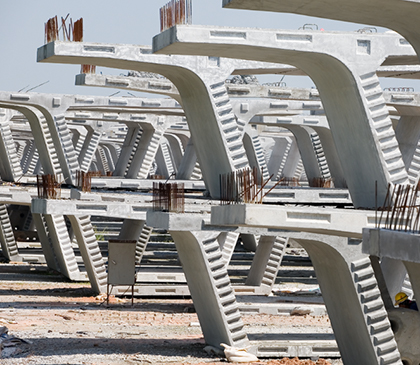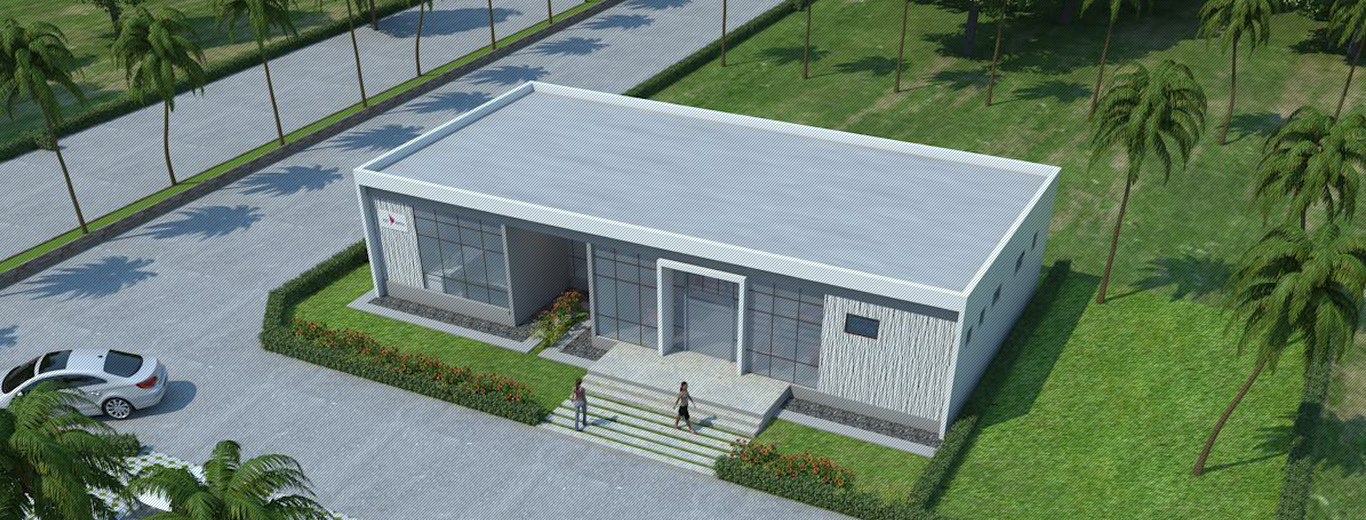Introduction
The precast construction industry has seen significant growth and innovation in recent years. As the world continues to urbanize and infrastructure projects become more complex, precast construction methods are gaining traction due to their efficiency and sustainability. This article delves into the global revenue in the precast industry, the countries at the forefront of adopting precast trends, and envisions a future for the industry 10 and 20 years from now. We will also explore the futuristic tools, equipment, and software that might shape the precast construction landscape, focusing on buildings, and discuss the role precast construction plays in global infrastructure development.

Fig 1: Precast Concrete
Courtesy: GCPAT.com
Global Revenue and Leading Countries in the Precast Industry
The global revenue in the precast industry is substantial and growing. The global precast concrete market size was estimated at USD 96.3 billion in 2021. It is projected to grow from USD 118.48 billion in 2021 to USD 159.85 billion in 2028 at a compound annual growth rate (CAGR) of 4.4% during the 2021-2028 period. Another source suggests that the global precast construction market size is expected to reach $227,567.1 million by 2030.
In terms of countries leading in the precast industry, the United States had the largest precast concrete market in 2022, followed by China and Japan. Germany and India were the next countries in the ranking.
As for the adoption of precast trends in the building industry, there are several key technical details that engineers globally should be aware of:
- Precast residential buildings involve designing, planning, lifting, handling, and transporting precast elements. This technology is suitable for constructing high-rise buildings resisting seismic and wind-induced lateral loads with gravity loads.
- At a precast manufacturing unit, roof slabs, wall panels, beams, columns, and floors are fabricated. There is a defined space for windows and doors. All fittings like electrical, plumbing, TV, telephone, etc. are laid before concreting.
- Precast RC frame structures (precast columns and precast beams) with precast floor slabs could be used for car parking structures.

Fig 2: Steel formwork for Precast Columns and Beams
Courtesy: Made-in-Chine.com
Precast Trends in Buildings: 10 Years into the Future
In the next 10 years, we can anticipate significant advancements in the precast construction industry, particularly in terms of sustainability and technology:
- Eco-Friendly Precast
The industry is expected to increasingly incorporate sustainable materials in precast elements, reducing its carbon footprint. For example, when evaluated, the field performance of the eco-friendly concrete slab system deployed in one of the existing tunnel sections of the Seoul Metro subway system showed that the new system’s performance using eco-friendly concrete was comparable or superior to the conventional system.
- 3D Printing
Emerging 3D printing technology is predicted to play a significant role in precast construction. 3D printing of concrete in precast forms takes about 8-11 hours. The process eliminates the need for a skilled carpenter, increasing efficiency in an already stretched-thin workforce. The 3D and 4D precast concrete forms have been shown to last through many castings without any signs of deterioration—at least not at the same rate as previous molds.
- Nanotechnology
In the precast industry, one example of the application of nanotechnology is a new admixture based on nanosized silicate hydrates (MeSH). This admixture is made by synthetic nanoparticles of a transition metal silicate hydrate, capable of catalyzing the hydration of the silicate phases of Portland cement and strongly accelerating the early strength development of cement mixtures. MeSH also promotes the precipitation of C-S-H not only on the cement grain surface but also in the capillary pores, with a consequent reduction of the capillary porosity of the hydrated cement paste and an improvement of the microstructure. At dosages of MeSH from 2 to 5 % by weight of cement, it is possible to completely eliminate the steam curing in the production of precast concrete elements without any adverse effect on the early strength and with a definite improvement of strength at longer ages and durability. Furthermore, the environmental impact of the concrete produced with MeSH and without steam curing, as measured by the LCA method, is about 12% less compared with that of normal steam-cured concrete.

Fig 3: Nanosized Silicate Hydrate
Courtesy: Mishra, 2022
Tools, Equipment, and Software: A Futuristic Perspective
- Smart Precast Factories
The future of precast construction will see the rise of smart factories that utilize advanced technologies to optimize the production process. These factories will be equipped with state-of-the-art machinery and automated systems that can manufacture precast elements with high precision and efficiency. The use of AI-driven systems will further enhance the production process by optimizing resource use, reducing waste, and improving the overall quality of the precast elements. From a structural engineering perspective, this means more accurate and consistent components, leading to safer and more reliable structures.
- Robotic Assembly
Robotic assembly is another significant advancement in precast construction. Robots can be programmed to perform complex assembly tasks with high accuracy and efficiency. These robots have four main platforms: robotic arm, mobile car, parallel axis, and fixed type. For instance, a robot can place a textile mold on top of a precast environment to erect a significant architectural object. This method allows the robotic casting process to obtain further contextual information to create highly customized assemblies.
ME.1943-5479.0000706/asset/c8dddeac-7a8b-427c-b92b-4de4aa4309b8/assets/images/large/figure1.jpg)
Fig 4: Robotics in Precast Industry
Courtesy: Pan, 2019
- Advanced Augmented Reality (AR) and Virtual Reality (VR)
AR and VR technologies are set to revolutionize the design and planning phases of precast construction. These technologies allow stakeholders to visualize projects in great detail before construction begins, thereby reducing errors and improving efficiency. AR and VR can be used to create immersive 3D models of precast components. This allows engineers and architects to visualize the design more realistically before it is actually manufactured. For example, AR can overlay digital information on top of the physical world, providing real-time information and guidance to workers on construction sites.

Fig 5: AR/VR in Precast Industry
Courtesy: Desapex
- Precast Printing
3D printing technology is making its way into precast construction. A study conducted using a model simulation combining the use of 3D printing from COBOD Company and observation on Project X precast production in PT Z factory showed that productivity improved by 50% compared to the original conventional method. The use of 3D printing technology resulted in faster productivity with less environmental impact. With the same area of production yard and the same number of human resources, a factory can speed up two times faster by replacing the casting method with 3D printers.
Global Automation and Infrastructure Development
Global Automation and Infrastructure Development are two significant areas that are shaping the future of engineering. Here’s how:
Global Automation:
- The global industrial automation market size was USD 191.89 billion in 2021 and is projected to grow from USD 205.86 billion in 2022 to USD 395.09 billion by 2029, at a CAGR of 9.8% during the forecast period.
- Automation, which is the use of technologies to make a process or a system operate automatically without human intervention, has a long history.
- Automation is less likely to diminish employment opportunities than it is to increase productivity.
- By removing technology barriers, universal automation allows manufacturing lines and industrial processes to be quickly reprogrammed by engineers as required, even remotely.
- Intelligent automation can create a new pathway toward achieving sustainable economies and energy transition.
Infrastructure Development:
- In 2020, China was the country with the highest spending on infrastructure worldwide.
- As of May 2022, Europe and the United States were the three most expensive infrastructure projects currently under development.
- According to the World Bank, new climate-smart infrastructure alone could cost low- and middle-income countries between 2% (US$640bn) and 8% (US$2.7tn) of GDP annually through 2030.
- Emerging markets are expected to account for most of the projected doubling of infrastructure spending by 2050, primarily through greenfield projects.
Conclusion
The precast construction industry is set to grow exponentially in the coming decades, with innovative technologies and sustainable practices at its forefront. As urban populations swell and infrastructure demands increase, the efficiency and precision of precast construction methods will prove invaluable. With visionary advancements on the horizon, this industry is poised to shape a more sustainable and connected world. As we look forward to the next 10 and 20 years, it is clear that precast construction is not just a building method; it is a blueprint for the future of construction and infrastructure development.
References
- https://www.grandviewresearch.com/industry-analysis/precast-concrete-market
- https://www.statista.com/statistics/1379359/precast-concrete-market-size-worldwide-by-country/
- https://www.fortunebusinessinsights.com/precast-concrete-market-103301
- https://www.alliedmarketresearch.com/precast-construction-market
- https://civilmint.com/precast-construction-technology/
- https://www.mgsarchitecture.in/building-materials-products/precast-peb/1922-why-precast-technology-is-important-for-construction.html
- https://www.cecr.in/precast-technology-1/precast-construction-in-india-and-its-future-ahead
- https://timesproperty.com/news/post/precast-technology-blid2764
- https://www.ijert.org/research/review-of-precast-concrete-technology-in-india-IJERTV10IS060400.pdf
- https://www.mordorintelligence.com/industry-reports/precast-concrete-market
- https://www.imarcgroup.com/precast-concrete-market
- https://www.globenewswire.com/news-release/2022/03/28/2410971/0/en/Precast-Concrete-Global-Market-Report-2022.html
- https://www.cement.org/designaids/emerging-trends
- https://www.mdpi.com/2076-3417/10/12/4140/htm
- https://link.springer.com/chapter/10.1007/978-981-16-6932-3_18
- https://www.pci.org/PCI_Docs/Papers/2018/16_Final_Paper.pdf
- https://link.springer.com/chapter/10.1007/978-981-99-3626-7_66
- https://scholar.ui.ac.id/en/publications/implementation-of-3d-concrete-printing-technology-in-precast-conc
- https://www.americanprecastfences.com/how-3d-printing-is-shaping-the-future-of-precast-concrete/
- https://www.fortunebusinessinsights.com/industry-reports/industrial-automation-market-101589

